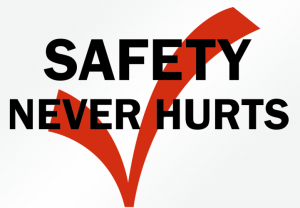Last month, I was asked to speak at a meeting of one of my long-term clients. The subject was “safety culture”. It’s something I’m interested in, but I decided I’d better do some research. And it turns out there is neither a consensus about what it is, nor that it is even needed!
The scientific paper I used
The paper is “Understanding and Exploring Safety Culture”, author Frank W Guldenmund, Delft University of Technology, 2010. I chose it simply because it sets out to summarise the short history of papers on the subject by a number of different researchers. It was heavy going! These people are social scientists. The terminology they use is about as opaque as it gets. But luckily, I studied sociology as part of my degree. Nevertheless, I couldn’t resist pasting a sample:
Take a deep breath..
 “However, when the empirical cycle starts iterating between deduction/prediction and testing, and proceeds with (limited) evaluation, it will operate within a vacuum where the underlying theory alienates more and more from the particular operationalisation and measurement. In that case the theoretical construct(s) underlying the measurement become(s) of secondary importance and leads to the rather pragmatic notion that construct x “is” what its test measures. Summarising, from a realist and positivist viewpoint the theoretical framework of the nomological network is linked to the empirical framework through the empirical cycle. By going through this cycle various times, the empirical framework is adapted to the theoretical one and vice versa. Thus, a close correspondence between theory and reality is established through well-chosen techniques that capture reality in a valid way”.
“However, when the empirical cycle starts iterating between deduction/prediction and testing, and proceeds with (limited) evaluation, it will operate within a vacuum where the underlying theory alienates more and more from the particular operationalisation and measurement. In that case the theoretical construct(s) underlying the measurement become(s) of secondary importance and leads to the rather pragmatic notion that construct x “is” what its test measures. Summarising, from a realist and positivist viewpoint the theoretical framework of the nomological network is linked to the empirical framework through the empirical cycle. By going through this cycle various times, the empirical framework is adapted to the theoretical one and vice versa. Thus, a close correspondence between theory and reality is established through well-chosen techniques that capture reality in a valid way”.
Hope you all got that?
Safety Culture definition
Definitions of safety culture differed between authors. But there were enough similarities to be able to generalise. Schein’s definition, (1992), is as good as any: For Schein, safety culture has a core of basic assumptions. You cannot “see” this. It’s surrounded by more tangible stuff that you can hear and see. He calls that outer, tangible layer “espoused values” and “artefacts“.
 To have an espoused value is to adhere to or advocate particular values. Examples might be “Safety is our number 1 priority”, or “We have a policy of Zero Harm”.
To have an espoused value is to adhere to or advocate particular values. Examples might be “Safety is our number 1 priority”, or “We have a policy of Zero Harm”.- Artefacts are essentially objects made by humans. Typically, they are of cultural or historical interest. Examples in safety might be policy statements, procedure manuals, conspicuous wearing of PPE, signs, posters, slogans, dress codes, words and language.
My question: Do people just “fall into line” with the values and behaviours they observe in their organisation? Are they acting out a part so that they can “fit in” or gain approval? If they leave that organisation for another, aren’t they likely to adopt the new organisational culture? So “safety culture” itself may be a façade?
History of safety culture
The term was coined by the International Nuclear Safety Advisory Group to describe the conditions prevailing at the Chernobyl power station prior to the incident in April 1986. The author of the paper I used, Frank Guldenmund says “In two decades (till 2010), the theory (safety culture) has not progressed much. There is little to support it as a valid idea, or that it is a predictor of improved safety, therefore (it) has not advanced beyond development stages”. Yes, you heard it right. Not only is there little evidence that it’s real, but it may not even help to make the place safer.
Here are similar comments made by some other researchers:
 Guion (1973): “The concept of organisational climate is undoubtedly important, but it also seems to be one of the fuzziest concepts to come along in some time.”
Guion (1973): “The concept of organisational climate is undoubtedly important, but it also seems to be one of the fuzziest concepts to come along in some time.”- Glick (1985): “A conceptual morass”, “may be so broad and diverse as to make the concept useless.”
- Douglas (1986): “Culture is a blank space, a highly respected, empty pigeonhole.”
- Schein (1992): “The concept (of organisational culture) is hard to define, hard to analyse and measure, and hard to imagine.”
Nevertheless, people attach importance to the concept and pursue it. In my opinion they are simply comfortable working with a vague concept. In the next section, we will see that one of the dominant ways that safety culture is acted out is using a “religious” perspective, where the struggle is the virtue, rather than the outcome. Read on.
Concepts of safety culture
Despite the above rather doubtful outlook, it is useful to understand the concepts (perceptions) of safety culture. Guldenmund outlined six:
- Scientific (A network of basic assumptions supporting behaviours).
- Belief (A “religious” perspective, requiring adherence and constancy).
- Sensitiser (Nothing concrete. Triggers people to look in the right places for it).
- Scrutiniser (Checking yourself in a mirror for improvements. Where are we at in the safety culture score sheet?)
- A thing (A machine, in which manual adjustments can be made. “Turn up the safety culture Joanne, we need some more”)!
- All the above. (I would add a 7th which is “Pick the one you like”. See below).
 Guldenmund refers to an old Indian tale: Three blind men were led to an elephant and asked to reach out and touch it. Let’s say the man touching the tail thought it was a rope, the one touching a leg thought it was a tree, the one with the tusk had a branch of the tree. The moral of the story is twofold:
Guldenmund refers to an old Indian tale: Three blind men were led to an elephant and asked to reach out and touch it. Let’s say the man touching the tail thought it was a rope, the one touching a leg thought it was a tree, the one with the tusk had a branch of the tree. The moral of the story is twofold:
- Be aware of your own partial truths, and;
- The truth may be a sum of all the parts.
So with the current safety culture thinking, we can all choose what’s “right for us”, or we can choose to work with an inexact idea of what the elephant looks like.
I would like to look in more detail at the first two concepts above, because I believe they are the two perceptions we mostly cling to: The Scientific and Belief concepts.
The “Scientific” and “Belief” concepts of safety culture
Scientific. (A network of values)
Safety culture is:
- Not a “thing”. You can’t touch it or manufacture it.
- A network of shared assumptions.
- A product of the mind.
- Based on consistencies we can see in an organisation.
- An assumption of a common meaning. This is known as “reification”. Example, wearing a wedding ring, which symbolises a common bond.
Interesting points in that for me are: First, it’s intangible. You can’t go out and build it. Secondly, the symbolic assumption of a “common meaning”, which overlaps with the following “Belief” model:
Belief. (Religious perspective)
JT Reason (1997) wrote: “Like a state of grace, a safety culture is striven for, but rarely attained. As in religion, the process is more important than the product. The virtue – and the reward – lies in the struggle rather than the outcome”.
Here are the characteristics of the “Belief” model. (The additions in brackets are my suggested equivalents in religious behaviour).
- Continuous drive for maximum safety – (onward Christian soldiers).
- Constant state of vigilance – (or the devil may take you).
- Frequent reminders and affirmations – (stay to the straight and narrow).
- A reporting culture – (confessions).
- A culture of responsibility – (I am my brother’s keeper).
- Conscientiousness and dedication required – (demonstrations of faith).
- Never question the way we do things – (no heretics please).
- Sayings like “The only acceptable risk is no risk” “Our target is zero harm” – (dogmas and commandments).
There is an atmosphere of earnest endeavour. Of struggling to fight the good fight. A motivational, table thumping approach. All this zealousness can turn people off. And not just the recipients. Having to be a disciple or messenger will be difficult unless you really are a true believer.
Guldenmund suggests that in this culture, the “Holy Grail” (my words) may never be reached; that if anyone ever felt it had been reached, it would lead to complacency, so goals are kept vague and out of reach. Example, the continuous improvement cycle. (Just as we achieve one target or plan, another higher one is created).
Summary of safety culture research
- Safety culture is hard to define and impossible to hold in your hands.
- There is little or no evidence it is a requirement, or even assists, with safer workplaces.
- It reflects shared beliefs at the core, plus consistent behaviours, and values that people demonstrate.
- You can’t manufacture the beliefs and behaviours.
What do you think?
Do you have any comments or observations? Please feel welcome to leave or send comments. What’s your safety culture? Do you even think it matters? If you want to change things, how will you go about doing it?
To me, the concept of safety culture is mostly to do with “doing things right”. It doesn’t have to be just about safety. Be determined to make order out of chaos, and give people responsibilities to enable them to take personal ownership.
I’ll start with an analogy:
 Let’s say we want a nice cup of tea (the safety culture).
Let’s say we want a nice cup of tea (the safety culture).- We have tea leaves and water.
- The water is not boiling, so we know it won’t make great tea with the flavour and aroma we need.
- There is no easy way. The only thing that really works is taking the time and energy to heat the water, pour it on your tea and stir. Then, we miraculously get flavour and aroma.
- Can you claim to have directly created the flavour and aroma? (The safety culture).
- Flavour and aroma is the product of doing things right with the water and tea, not something you can separately create. It happens because a number of factors are right for it. It’s more than the sum of all the parts. It’s spontaneous.
- You can’t adjust it or manufacture it.
- So do you even own it or control it?
So what are the things you can do to facilitate “safety culture”? (My opinion)
- Leadership: Take time to “do things right”. An organised workplace is simpler, more productive and safer. You don’t have to be the safety priest, but you have to sell the simplicity and benefits.
- Inclusiveness: Without employee interest, there is no such thing as a safety culture. Think how much easier it is when employees “take some ownership” of safety. So delegate, encourage sharing of duties and respect participation by workers.
- You don’t need to be passionate about safety. People might turn off. Just do simple stuff well. It’s not only about safety. It’s about the quality of the organisation. Everyone benefits.
- Do you even need “safety culture”? (When was the last time you saw your CFO being passionate about a “finance culture”?)
- Have a healthy level of suspicion about safety mantras. They are essentially symbolic. But they are there to remind us that safety does require more than a passing interest.
- Walk the talk. Mean it. Listen. Be fair and consistent. Remember: “What interests my boss fascinates me”. And the converse of that is also true….
Simon Lawrence
Simon Lawrence is Director of SafetyPro Limited.
Consulting for safety.
Call 0800 000 267 for a welcoming chat, or email simon@safetypro.co.nz
Check out our SafetyBase software
- View a 4 minute video overview. Please like or share.
- Browse the SafetyBase website.
- Short cut to the all-important Pricing Page. No hidden costs.
- Download a PDF Fact Sheet to show to your Senior Leadership Team.
Call me, Simon, on 0800 000 267 or email simon@safetypro.co.nz You could be trying out this highly effective health and safety software system in minutes.

